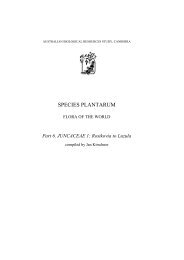Introduction - Species Plantarum Programme
Introduction - Species Plantarum Programme
Introduction - Species Plantarum Programme
Create successful ePaper yourself
Turn your PDF publications into a flip-book with our unique Google optimized e-Paper software.
40<br />
SPECIES PLANTARUM — FLORA OF THE WORLD (1999)<br />
autapomorphic: of a character, derived and unique to a given taxon or monophyletic group.<br />
autochthonous: of the inhabitants of a region, original; earliest known; (applied to an<br />
element of the Australian flora rich in endemics and believed to have been evolving in<br />
Australia for a long period of time).<br />
autotrophic: independent of other organisms in respect of organic nutrition; able to fix<br />
carbon dioxide, by photosynthesis, to form carbohydrates.<br />
auxotelic: applied to inflorescences, parts of inflorescences or to axes that do not end in a<br />
flower, and in which growth continues beyond the flowering region, cf. anauxotelic.<br />
awn: a bristle-like appendage, e.g. on the tip or back of the lemma of a grass floret.<br />
axil: the angle between a leaf or bract and the axis bearing it. adj. axillary.<br />
axile: on an axis; of a placenta, on the central axis of the ovary.<br />
axis: a stem, (commonly used for the main stem of a whole plant or of an inflorescence).<br />
baccate: berry-like; of seeds, having a succulent or pulpy testa; of fruits, having the seeds<br />
embedded in pulp.<br />
barbellae: short, straight, stiff hairs or barbs.<br />
barbulae: in Scaevola (Goodeniaceae), outgrowths on the margin of the wings or in the<br />
throat of the corolla, sometimes with apical hairs or papillae.<br />
basal: at the base; of a placenta, at the base of the ovary.<br />
basifixed: attached at or by the base, e.g. of anthers, by the base of the connective. cf.<br />
medifixed, versatile.<br />
basipetal: developing, in sequence, from the apex towards the base. cf. acropetal.<br />
basiscopic: of the first lateral vein of a leaflet on the side nearer the leaf base, pointing<br />
towards the base.<br />
basitonic: of flowering seasonal growth units (seasonal shoots), producing no leaves (but<br />
sometimes some bracts) below the inflorescence, cf. acrotonic.<br />
beak: a prominent terminal projection, especially of a carpel or fruit.<br />
berry: a fleshy or pulpy indehiscent fruit with the seed(s) embedded in the fleshy tissue of<br />
the pericarp. cf. drupe, pyrene.<br />
biennial: a plant whose life span extends for more than one but less than two years after<br />
germination.<br />
bifacial: of leaves, flat or channelled with distinct adaxial and abaxial surfaces.<br />
bifid: divided, for about half the length, into two parts. cf. bipartite.<br />
bifoliate: of plants, having two leaves.<br />
bifoliolate: of leaves, having two leaflets.<br />
bigeminate: in two pairs; of pinnate leaves, having only two pairs of pinnae.<br />
bilabiate: two-lipped, e.g. of a corolla in which fusion of an anterior group and a posterior<br />
group of petals extends beyond the top of the corolla tube.<br />
bilamellate: consisting of two plates or lamellae.<br />
bilocular: having two cavities.<br />
bipartite: divided, nearly to the base, into two parts. cf. bifid.<br />
bipinnate: of leaves, twice pinnately divided. cf. pinnate, tripinnate.












